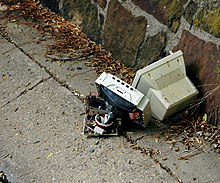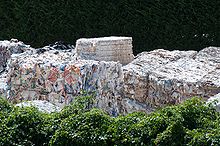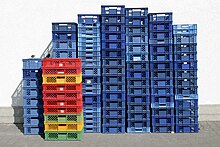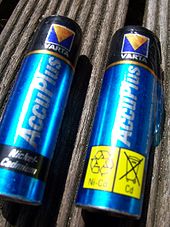Recycling by product
Products made from a variety of materials can be recycled using a number of processes.
Building and construction waste[]
Aggregates and concrete[]

Concrete aggregate collected from demolition sites is put through a crushing machine, often along with asphalt, bricks, dirt, and rocks. Smaller pieces of concrete are used as gravel for new construction projects. Crushed recycled concrete can also be used as the dry aggregate for new concrete if it is free of contaminants. Builder's rubble (like broken down bricks) is also used for railway ballast and gravel paths. This reduces the need for other rocks to be dug up, which in turn saves trees and habitats.
Asphalt and tarmac[]
Asphalt including asphalt shingle can be melted down and in part recycled. Tarmac can also recycled and there is now an active market for recycling tarmac in the developed world.[1] This includes tarmac scalpings produced when roads are scarified before a new surface is laid.
Gypsum, plaster and plasterboard products[]
Because up to 17% of gypsum products are wasted during the manufacturing and installation processes. Wallboard (Australia and others), plasterboard, Gyp (New Zealand), drywall (USA) or plasterboard (UK and Ireland) is frequently not re-used and disposal can become a problem. Some landfill sites have banned dumping of gypsum because of the tendency to produce large volumes of hydrogen sulfide gas. Some manufacturers take back waste wallboards from construction sites and recycle it into new wallboard.[2] Gypsum waste from new construction, demolition and refurbishment activities can be turned into recycled gypsum through mechanical processes, and the recycled gypsum obtained can replace virgin gypsum in the Gypsum Industry. Some of the reasons for recycling this waste are:
- Gypsum is one of the few construction materials for which closed loop recycling is possible.[3]
- Closed loop gypsum recycling saves virgin gypsum resources.
- According to the European Directive 2008/98/EC on Waste,[4] recycling should be preferred to recovery and landfill disposal.
- This Directive also establishes that the preparing for re-use, recycling and other material recovery of non-hazardous Construction and Demolition (C&D) waste (excluding soil and stones other that those containing dangerous substances) have to be increased to a minimum of 70% by weight by 2020.
- The disposal of gypsum-based materials can become a problem if they are accepted at normal cells in non-hazardous landfills, as the sulphate content of gypsum mixed with organic waste can break down under certain conditions into hydrogen sulfide gas.
Bricks[]
Intact bricks recovered from demolition can be cleaned and re-used.
Batteries[]
The large variation in size and type of batteries makes their recycling extremely difficult:[7] they must first be sorted into similar kinds and each kind requires an individual recycling process. Additionally, older batteries contain mercury and cadmium, harmful materials that must be handled with care. Because of their potential environmental damage, proper disposal of used batteries is required by law in many areas. Unfortunately, this mandate has been difficult to enforce.[8]
Lead-acid batteries, like those used in automobiles, are relatively easy to recycle and many regions have legislation requiring vendors to accept used products. In the United States, the recycling rate is 90%, with new batteries containing up to 80% recycled material.[8]
Japan, Kuwait, the USA, Canada, France, the Netherlands, Germany, Austria, Belgium, Sweden, the UK and Ireland all actively encourage battery recycling programs.[5][6][9][10] In 2006, the EU passed the Battery Directive of which one of the aims is a higher rate of battery recycling. The EU directive said at least 25% of all the EU's used batteries must be collected by 2012, and rising to no less than 45% by 2016, of which, that at least 50% of them must be recycled.[10]
Biodegradable waste[]
Kitchen, garden, and other green waste can be recycled into useful material by composting into leaf mold and regular compost. This process allows natural aerobic bacteria to break down the waste into fertile topsoil. Much composting is done on a household scale, but municipal green-waste collection programs also exist. These programs can supplement their funding by selling the topsoil produced.
Electronic waste[]
Electronics disassembly and reclamation[]

Electronic recycling is recycling or reuse of computers or other electronics. It includes both finding another use for materials (such as donation to charity), and having systems dismantled in a manner that allows for the safe extraction of the constituent materials for reuse in other products. The direct disposal of electrical equipment—such as old computers and mobile phones is banned in many areas, such as the UK, parts of the USA, Japan, Ireland, Germany and the Netherlands, due to the toxic contents of certain components. The recycling process works by mechanically separating the metals, plastics, and circuit boards contained in the appliance. When this is done on a large scale at an electronic waste recycling plant, component recovery can be achieved cost-effectively.
With high lead content in CRTs, and the rapid diffusion of new flat-panel display technologies, some of which (LCDs) use lamps containing mercury, there is growing concern about electronic waste from discarded televisions. Related occupational health concerns exist, as well, for disassemblers and scrap dealers removing copper wiring and other materials from CRTs. Further environmental concerns related to television design and use relate to the devices' increasing electrical energy requirements.[11]
Computers that are termed trashware in North America or totally reconditioned hardware in the UK and Ireland are computer equipment that has assembled from old hardware, using cleaned and checked parts from different computers, for use by disadvantaged people to bridge the digital divide. Trashware is different from retrocomputing, which has only cultural and recreational purposes.
Ink jet printer cartridges[]

Because printer cartridges from the original manufacturer are often expensive, demand exists for cheaper . These include ink sold in bulk, , machines in stores that automatically refill cartridges, re-manufactured cartridges, and cartridges made by a corporate entity other than the original manufacturer.
Consumers can refill ink cartridges themselves with a kit, or they can take the cartridge to a refiller or re-manufacturer where ink is pumped back into the cartridge. PC World reports that refilled cartridges have higher failure rates, print fewer pages than new cartridges, and demonstrate more on-page problems like streaking, curling, and colour bleed.[12]
Metals[]
A wide range of metals in commercial and domestic use have well developed recycling markets in most developed countries. Domestic recycling is commonly available for Iron[13] and steel, aluminium[13] and in particular beverage and food cans. In addition, building metals such as copper,[14] zinc[15] and lead[16] are readily recyclable through specialised companies. In the UK, these are usually either specialised scrap dealers or car breakers. Other metals present in smaller quantities in the domestic waste stream such as tin[17] and chromium are also extracted from metal put into the recycling system but are rarely recovered from the general waste stream.
Paint[]
Paper and newsprint[]

Paper and newsprint can be recycled by reducing it to pulp and combining it with pulp from newly harvested wood. As the recycling process causes the paper fibres to break down, each time paper is recycled its quality decreases. This means that either a higher percentage of new fibres must be added, or the paper down-cycled into lower quality products. Any writing or colouration of the paper must first be removed by deinking, which also removes fillers, clays, and fibre fragments.[18]
Almost all paper can be recycled today, but some types are harder to recycle than others. Papers coated with plastic or aluminium foil, and papers that are waxed, pasted, or gummed are usually not recycled because the process is too expensive.[18]
Sometimes recyclers ask for the removal of the glossy paper inserts from newspapers because they are a different type of paper. Glossy inserts have a heavy clay coating that some paper mills cannot accept. Most of the clay is removed from the recycled pulp as sludge, which must be disposed of. If the coated paper is 20% by weight clay, then each ton of glossy paper produces more than 200 kg of sludge and less than 800 kg of fibre.[18]
The price of recycled paper has varied greatly over the last 30 or so years.[19] [20][21] [22][23][24] The German price of €100/£49 per tonne was typical for the year 2003 [21] and it steadily rose over the years. By the September 2008 saw the American price of $235 per ton, which had fallen to just $120 per ton,[19] and in the January 2009, the UK's fell six weeks from about £70.00 per ton, to only £10.00 per ton.[22] The slump was probably due to the economic down turn in East Asia leading to market for waste paper drying up in China.[22] 2010 averaged at $120.32 over the start of the year, but saw a rapid rise global prices in May 2010,[20] with the June 2010 resting $217.11 per ton in the USA as China's paper market began to reopen![20]
Mexico, America, the EU, Russia and Japan all recycle paper en masse and there are many state run and private schemes running in those countries. In 2004 the paper recycling rate in Europe was 54.6% or 45.5 million short tons (41.3 Mt).[25] The recycling rate in Europe reached 64.5%3 in 2007, which confirms that the industry is on the path to meeting its voluntary target of 66% by 2010.[26]
Plastic[]

Plastic recycling is the process of recovering scrap or waste plastics and reprocessing the material into useful products. Compared to glass or metallic materials, plastic poses unique challenges. Because of the massive number of types of plastic, they each carry a resin identification code, and must be sorted before they can be recycled. This can be costly; while metals can be sorted using electromagnets, no such 'easy sorting' capability exists for plastics. In addition to this, while labels do not need to be removed from bottles for recycling, lids are often made from a different kind of non-recyclable plastic.
To help in identifying the materials in various plastic items, resin identification code numbers 1-6 have been assigned to six common kinds of recyclable plastic resins, with the number 7 indicating any other kind of plastic, whether recyclable or not. Standardized symbols are available incorporating each of these resin codes.
Rubber Tires[]

Tire recycling or rubber recycling is the process of recycling vehicles tyres that are no longer suitable for use on vehicles. These tyres are among the largest and most problematic sources of waste, due to the large volume produced and their durability. Those same characteristics which make waste tyres such a problem also make them one of the most re-used waste materials, as the rubber is very resilient and can be reused in other products. In the United States, approximately one tyre is discarded per person per year. However, material recovered from waste tyres, known as "crumb" is generally only a cheap "filler" material and is rarely used in high volumes. Tyre recycling is also fairly common. Used tires can be added to asphalt for producing road surfaces or to make rubber mulch used on playgrounds, basketball courts and new shoe products. They are also often used as the insulation and heat absorbing/releasing material in specially constructed homes known as earthships. It is arguable that tire crumb in applications such as basketball courts could be better described as "reused" rubber rather than "recycled".
Ship breaking[]

Ship breaking is a type of ship disposal involving breaking up ships for scrap recycling, with the hulls being discarded in ship graveyards. Most ships have a lifespan of a few decades before there is so much wear that refitting and repair becomes uneconomical. Ship breaking allows materials from the ship, especially steel, to be reused. Equipment on board the vessel can also be reused. Until the late 20th century, ship breaking took place in port cities of industrialized countries such as the United Kingdom and the United States. Today, most ship breaking yards are in Alang in India, Chittagong in Bangladesh, Aliağa in Turkey and Gadani near Karachi in Pakistan. Ship breaking is one example that has associated environmental, health, and safety risks for the area where the operation takes place; balancing all these considerations is an environmental justice problem.
Textiles[]
In many countries, there is an active market in re-selling used clothes. In Britain, this dominated by charity shops who sell donated clean clothes. Less saleable clothes are put into the re-cycling waste stream. Textiles are made of a variety of materials including cotton, wool, synthetic plastics, linen, modal and a variety of other materials. The textile's composition will affect its durability and method of recycling.
Textiles entering the re-cycling stream are sorted and separated by workers into good quality clothing and shoes which can be reused or worn. There is a trend of moving these facilities from developed countries to developing countries either for charity or sold at a cheaper price.[27] Many international organisations collect used textiles from developed countries as a donation to those third world countries. This recycling practise is encouraged because it helps to reduce unwanted waste while providing clothing to those in need.[28] Damaged textiles are further sorted into grades to make industrial wiping cloths and for use in high quality paper manufacture or material suitable for fibre reclamation and filling products. If textile reprocessors receive wet or soiled clothes, however, these may still be disposed of in a landfill, as the washing and drying facilities may not be present at sorting units.[29]
Fibre reclamation mills sort textiles according to fibre type and colour. Colour sorting eliminates the need to re-dye the recycled textiles. The textiles are shredded into "shoddy" fibres and blended with other selected fibres, depending on the intended end use of the recycled yarn. The blended mixture is carded to clean and mix the fibres and spun ready for weaving or knitting. The fibres can also be compressed for mattress production. Textiles sent to the flocking industry are shredded to make for , roofing felts, loudspeaker cones, and .
According to Earth911.com, "Metal hangers, while made of steel, can be difficult to recycle because their hooks can damage recycling equipment and some have a petroleum coating. Some curbside recycling programs do accept them.... Many dry cleaners take back hangers, too...."[30]
Chat and furnace slag[]
In North America, mine chat waste can be used on snow-covered roads to improve traction; as gravel; and as construction aggregate, principally for railway ballast, highway construction, and concrete production. Furnace slag and to a lesser degree coal slag have been used in lieu of construction and railway ballast gravel in the UK. Clinker, slag, fly ash and in some cases ashes have all historically been used in places such as the industrial parts of Yorkshire and South Wales to make domestic cinder paths.
See also[]
- Recycling by material
- Index of recycling topics
- Henrik Lund-Nielsen
- Gypsum recycling
References[]
- ^ Netregs - Guidance on Roadstone coating processes
- ^ Plasterboard recycling
- ^ EUROGYPSUM, Environmental and Raw Material Committee. Factsheet on: What is gypsum? "Archived copy" (PDF). Archived from the original (PDF) on 2013-12-02. Retrieved 2013-11-25.CS1 maint: archived copy as title (link) Retrieved 16 December 2013.
- ^ The European Parliament and The Council of the European Union. Directive 2008/98/EC on waste (Waste Framework Directive). Official Journal L 312 , 22/11/2008 P. 0003 - 0030. http://eur-lex.europa.eu/LexUriServ/LexUriServ.do?uri=CELEX:32008L0098:EN:NOT Retrieved 16 December 2013.
- ^ Jump up to: a b "Recycling News Exchange Listings -- Recycler's World".
- ^ Jump up to: a b Hurd, David C. (1993). Recycling of consumer dry cell batteries. Park Ridge, N.J: Noyes Data Corp. ISBN 0-8155-1325-9.
- ^ Harper, Gavin; Sommerville, Roberto; Kendrick, Emma; Driscoll, Laura; Slater, Peter; Stolkin, Rustam; Walton, Allan; Christensen, Paul; Heidrich, Oliver; Lambert, Simon; Abbott, Andrew; Ryder, Karl; Gaines, Linda; Anderson, Paul (November 2019). "Recycling lithium-ion batteries from electric vehicles". Nature. 575 (7781): 75–86. Bibcode:2019Natur.575...75H. doi:10.1038/s41586-019-1682-5. PMID 31695206.
- ^ Jump up to: a b "Batteries - Municipal Solid Waste (MSW)". United States Environmental Protection Agency. Retrieved 2008-02-21.
- ^ "Archived copy". Archived from the original on 2012-10-15. Retrieved 2012-10-15.CS1 maint: archived copy as title (link)
- ^ Jump up to: a b "EU agrees battery recycling law". BBC News. 2006-05-03.
- ^ "The Rise of the Machines: A Review of Energy Using Products in the Home from the 1970s to Today" (PDF). Energy Saving Trust. July 3, 2006. Archived from the original (PDF) on August 8, 2007. Retrieved 2007-08-31.
- ^ "Printers: Refills or new cartridges?". PCWorld.ca. 2007-04-03. Archived from the original on 2007-06-05. Retrieved 2009-07-22.
- ^ Jump up to: a b Metals - aluminium and steel recycling Archived 2007-10-16 at the Wayback Machine
- ^ Recycling of Copper
- ^ Zinc recycling
- ^ Lead recycling
- ^ Tin recycling
- ^ Jump up to: a b c "EarthAnswers - How is Paper Recycled?". Archived from the original on 2008-04-13. Retrieved 2008-02-23.
- ^ Jump up to: a b "Archived copy". Archived from the original on 2009-04-12. Retrieved 2010-07-01.CS1 maint: archived copy as title (link)
- ^ Jump up to: a b c "Recycling and Composting Online".
- ^ Jump up to: a b Tomlinson, Heather (2003-04-06). "Recycled paper up in price". The Independent. London.[dead link]
- ^ Jump up to: a b c http://www.wildaboutbritain.co.uk/forums/waste-recycling-and-pollution/46521-paper-recycling-crisis.html
- ^ "Loose Waste Paper Exchange Listings".
- ^ "A Paper Recycling Business - Startup Guide".
- ^ "ERPC Facts and Figures". European Recovered Paper Council (ERPC). Archived from the original on 2007-09-30. Retrieved 2006-09-27.
- ^ "European Declaration on Paper Recycling 2006–2010. Monitoring Report 2007" (PDF). European Recovered Paper Council. Archived from the original (PDF) on 2009-09-07. Retrieved 2009-01-17.
- ^ "UK reliance on foreign textile sorting "frightening"". Letsrecycle.com. 2006-11-08. Retrieved 2010-06-19.
- ^ "Salvation Army". Retrieved 2008-02-29.
- ^ "Councils "need to understand" importance of textile quality". Letsrecycle.com. 2006-11-24. Retrieved 2010-06-20.
- ^ "10 Things in Your Closet You Can Reuse or Recycle". Retrieved 2014-02-09.
External links[]
- Recycling by product

